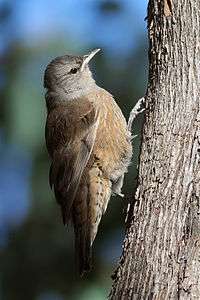Australasian treecreeper
| Australasian treecreepers | |
|---|---|
 | |
| Brown treecreeper | |
| Scientific classification | |
| Kingdom: | Animalia |
| Phylum: | Chordata |
| Class: | Aves |
| Order: | Passeriformes |
| Suborder: | Passeri |
| Family: | Climacteridae de Sélys Longchamps, 1839 |
| Genera | |
There are 7 species of Australasian treecreeper in the passerine bird family Climacteridae. They are medium-small, mostly brown birds with patterning on their underparts, and all are endemic to Australia-New Guinea. They resemble, but are not closely related to, the Holarctic treecreepers. The family is one of several families identified by DNA-DNA hybridisation studies to be part of the Australo-Papuan songbird radiation. There is some molecular support for suggesting that their closest relatives are the large lyrebirds.
As their name implies, treecreepers forage for insects and other small creatures living on and under the bark of trees, mostly eucalypts, though several species also hunt on the ground, through leaf-litter, and on fallen timber. Unlike the Holarctic treecreepers they do not use their tail for support when climbing tree trunks, only their feet.
Australasian treecreepers nest in holes in trees. The species in the family hold breeding territories, although the extent to which they are defended and last varies. Some species, such as the red-browed treecreeper and the brown treecreeper are cooperative breeders, others, like the white-throated treecreeper are not. The cooperative breeders form groups or a single breeding pair as well as up to three helpers, which are usually the young males of previous pairings. Helpers assist with the construction of the nest, feeding of the incubating female and feeding and defending the young.
Taxonomy
- Genus Cormobates
- Papuan treecreeper, Cormobates placens
- White-throated treecreeper, Cormobates leucophaea
- Genus Climacteris
- White-browed treecreeper, Climacteris affinis
- Red-browed treecreeper, Climacteris erythrops
- Brown treecreeper, Climacteris picumnus
- Black-tailed treecreeper, Climacteris melanurus
- Rufous treecreeper, Climacteris rufus
References
- Del Hoyo, J.; Elliot, A. & Christie D. (editors). (2007). Handbook of the Birds of the World. Volume 12: Picathartes to Tits and Chickadees. Lynx Edicions. ISBN 978-84-96553-42-2
- Noske, N.A. (1991). "A Demographic Comparison of Cooperatively Breeding and Noncooperative Treecreepers (Climacteridae)". Emu 91 (2) 73 - 86
- Sibley, C.G.; Schodde, R. & J.E. Ahlquist (1984) "The relationship of the Australo-Papuan Treecreepers Climacteridae as indicated by DNA-DNA hybridization". Emu 84 (4): 236 - 241
- Christidis, L.; Norman, J.; Scott, I. & M Westerman (1996) "Molecular Perspectives on the Phylogenetic Affinities of Lyrebirds (Menuridae) and Treecreepers (Climacteridae)". Australian Journal of Zoology 44 (3) 215 - 222
External links
| Wikimedia Commons has media related to Climacteridae. |
- Australasian Treecreeper videos on the Internet Bird Collection